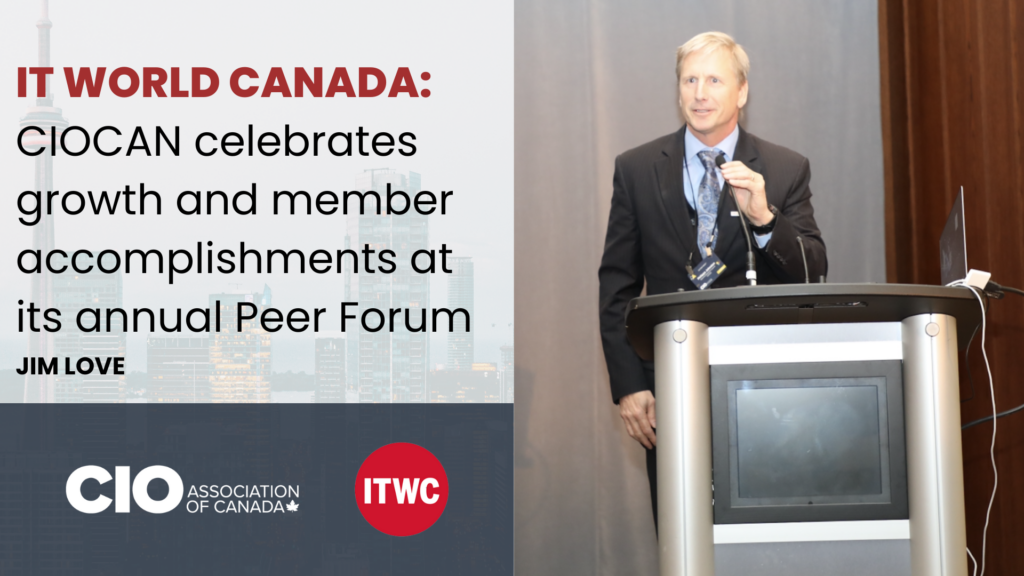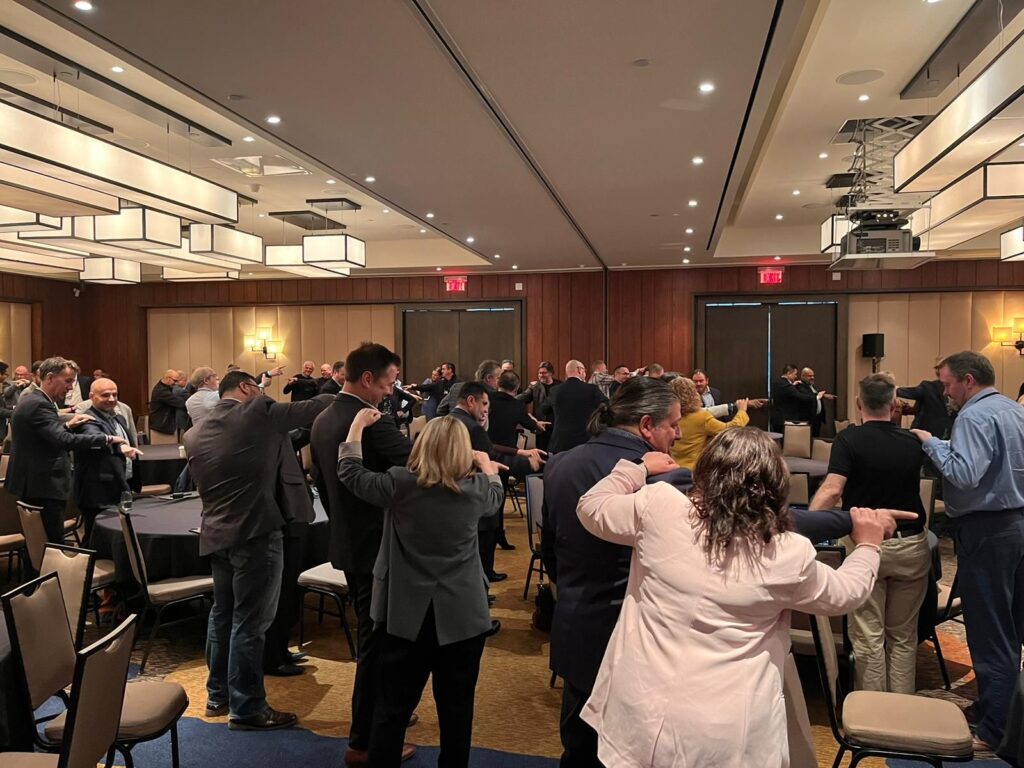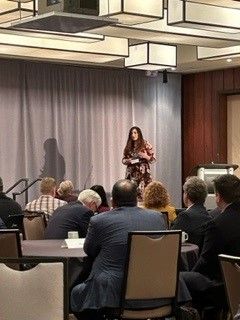With the Peer Forum now in our rear-view mirror, we are highlighting some of the activities from the event.
Speaker slide decks are now available to members in the Info Hub by following this link.
More content will be added to this page as available.
IT World Canada: CIOCAN celebrates growth and member accomplishments at its annual Peer Forum *Click to read article*

Key takeaways from The CIO Peer Forum 2023 by Meta IT

What’s the biggest disruption coming on right now? Many attendees answered AI, Chat GPT, Metaverse, IoT, and others. But the CIO Peer Forum this year, in its first in-person annual conference post-pandemic, came to help better understand one of, if not the, biggest matter when it comes to innovating: how to balance it with massive time-consuming operational tasks and deliveries. At the end of the day, that’s the role of the CIO: creating and perpetuating innovation and disruption as a culture.
Important questions and concerns were brought up during the Forum, and we from Meta IT, as proud Gold Sponsors and fosters of innovation and the agile culture, will bring you first-hand key insights.
How do you build something from the ground up and be innovative at the same time? And, while growing, how do you continuously foster an innovation culture?

According to Nico Gonzalez, CDO at Paradise Mobile, an esteemed client of ours, there are three pillars to start building an innovative business: a good infrastructure, a product that truly looks into the future, and key partners that allow you to scale and be agile with flexibility. Culture starts with your company’s Manifesto, the way you live every day: how you think and see each process, delivery, and client. Agility must be rooted; the model beside shows how to do it.
Once you have a good base and grow, three other pillars become essential:
- Psychological safety: encouraging people to give feedback is the foundation of a different way of thinking, and the only way to know how things are really going. According to Nico, “creating a culture where people feel encouraged and empowered to speak changes the dynamic”.
- Transparency: it’s a true way of living, not only an organizational strategy. “I would never say anything about you behind closed doors that I wouldn’t just tell you in a feedback session”. Nico also reinforces that it connects to what systems you use and how they enable transparency, and if it’s clear and visible who is working on what.
- Allow people to try: your team must be able to test and fail. “It’s easy to say, it’s hard to do. But allowing everybody within your organization to experiment has a massive effect”. The same applies to your partners, they must allow you to experiment new approaches safely and efficiently, as Meta IT is supporting Paradise Mobile in its launching journey.
“You have to get fired every day.”
Disruption for itself doesn’t disrupt, and it’s not a smart choice if you want to become truly indispensable – considering current times of multiple layoffs. According to Shawn Kanungo, a globally recognized strategist, and the speaker at the Peer Forum opening keynote presentation, it’s about being “dangerous” and risky (like you could be fired for that!). It means being bold enough to challenge established industries, yet practical enough to rebuild them.
Companies from different sectors have faced drastic changes in their business models and in the way they serve their customers, all thanks to the technological innovations that are constantly emerging. Considering the speed it happens, it’s important to establish flexible partnerships to access resources, knowledge, and skills lacking in-house to quickly adapt and stay a step ahead of the competition.
(Neuro)diversity: where culture and human aspects converge.
Discussions around diversity in an organizational scenario usually thrive on age, class, ethnicity, gender, race, sexual orientation, and other human differences. But there’s also another side to be considered: neurodivergent people. Richard Branson, founder of the Virgin Group and who himself is dyslexic, defends that AI cannot replicate the unique insight and innovation of people with dyslexia.
Although there are different concepts on the subject, neurodiversity can be defined based on the principle that neurodivergent people do not need to be treated, cured, or isolated from society. What they do need is understanding, and the business case for diversity, equity, and inclusion (DE&I) is stronger than ever.
While correlation does not equal causation (greater gender and ethnic diversity in corporate leadership doesn’t automatically translate into more profit), the correlation does indicate that when companies commit themselves to diverse leadership, they are more successful, as we can see in “Why diversity matters”, McKinsey:
- Companies in the top quartile for racial and ethnic diversity are 35% more likely to have financial returnsabove their respective national industry medians.
- Companies in the top quartile for gender diversity are 15% more likely to have financial returns above their respective national industry medians.
According to the study, the greater the representation, the higher the likelihood of outperformance. Companies with more than 30% women executives were more likely to outperform companies where this percentage ranged from 10 to 30, and in turn, these companies were more likely to outperform those with even fewer women executives, or none at all. And how about neurodivergent people? That’s where the next step is.
How to stay secure in a world that is occupied by technology?
Alongside the last years’ great technology development, the more we are daily exposed to various threats, compromising the company, the clients, and our own safety. For this reason, the PIPEDA (Personal Information Protection and Electronic Documents Act), Canada’s federal personal data protection law, is essential for the activities carried out by all stakeholders.
PIPEDA’s principles must be rooted within the organization: responsibility; purpose identification; consent; limitation of obtaining information; limiting the use, disclosure, and retention of data; precision; safeguards; opening; individual access and compliance inquiry. In a fast-changing world, keeping platforms, software and processes updated is the key to avoiding safety problems. Digital transformation (DX) is not only a technological and cultural evolution, but a safer way to navigate and deliver. New menaces are constantly created; therefore, we need to consistently review internal assets and evolve.
In the end, how can we balance it?
Bridging innovation and delivery is indeed a balancing act: it doesn’t compete with the daily operational tasks; it is a change of mindset that will be embedded in every future action. As a key final insight on this year’s Peer Forum, it’s important to remember that there are three factors to successfully continue to scale: trust, transparency, and accountability. And having the right partners by your side will facilitate rooting and fostering innovation from the inside out.
- Trust: you must trust in who shares the daily work with you, believe that everyone is there for the same purpose, and they will do everything in their power to achieve excellence together. “If you delegate tasks, you create followers. If you delegate authority, you create leaders”, Craig Groeschel.
- Transparency: regular honest feedback sessions are proven to be efficient to encourage a respectful interpersonal relationship, the key to fostering genuine collaboration. The team will be more focused and engaged, better-understanding priorities and promoting your company’s values and goals.
- Responsibility: understanding and clarifying each person’s responsibilities is the first step toward this balance. In addition, there’s a need to comprehend what and whom to ask something, considering personal and professional lives balance.
Scaling these three aspects above, you’ll be able to maintain operation and innovation evolving at the same time as part of your company’s culture. Keeping it simple, digital, and human is the priority to achieve true balance, therefore carefully choosing who’s by your side is a game-changing move. DX exists to optimize resources, simplify processes, reduce time, and generate better results. Meta IT exists to make this transformation simple and possible. Count on us as a long-term trustable partner to quickly scale and continuously evolve with flexibility and agility.
Simon Trevarthen Keynote Summary by Peyman Parsi
The Deadline is Today ….. The Future is Now!
This session was about how to balance the tension between Innovation and delivery, respond to the move toward disruption while still keeping the lights on, and deliver on existing commitments.
Simon suggested six important elements to be considered and acted upon:
Innovation:
What is the “Innovation” definition?
IDEAS + ACTIONS = VALUES
Turn IDEAS into products and services by ACTIONS and create VALUES for your organization or your customers.
Characteristics of Values:
VALUES: (See – Solve – Need) must be observable, solve a business problem and respond to a need
Notable Innovative Trends:
- Artificial Intelligence – spread everywhere
- Connectivity – everyone’s ability to connect
- Biotech – health, DNA, predictions
- CleanTech – sustainability
- Mobility – usage by everyone
- Machine Learning – every insight
- Robotics Automation – processes
“Delivery” is more about stability, processes, and getting to the result for today vs. “ Innovation” is about chaos, disruption, and growth for tomorrow.
Leadership:
Leadership starts with breaking mental paths and disrupting the mind. There is no shortage of ideas by people or organizations. What is more important is to have Ideas aperture to explore, narrow down, focus, and control the ideas and have the right leadership.
Culture:
Culture is about empowerment, building trust, and unifying the purpose. Often there is a communication breakdown in large organizations due to heavy processes which results in culture challenges. Examine how porous is your organization to new ideas and be mindful that “Innovation” doesn’t happen in the middle, happens in the margins.
Network:
Consider the Network like topology as your org structure, less hierarchical while still keeping people accountable. The organization becomes more responsive, resilient, and solves problems quickly however this depends on trust, autonomy, and unified purpose. Successful examples can be found in pilot training or special forces with great ability to respond quickly and at the moment.
Bandwidth:
“Change” is dynamic and disruptive and is the process of becoming something different.
Evaluate can your org absorb the bandwidth required by the change i.e. Change Ingestion.
Consider two dimensions: Create a chart of the “Effort” vs. “Impact” axis, with layers of process innovation, capability innovation, and growth innovation graph. Then decide on your realistic bandwidth. Be aware: If you have no bandwidth for disruption means no growth.
Quality:
Quality is about consistently high standards and reduction of tolerance. The key here is “Consistency”. To create higher quality products and services there are 3 dimensions to consider:
- Transaction (accuracy, completeness, timely) – Process Innovation
- Behavior (human factors) – UX design thinking
- Decisions (right result) – AI/ML learning
Examples of high-quality operations: Amazon warehouse robotics and automation at scale
Resilience:
Resilience doesn’t mean being rock-hard and strong rather is more about adaptability and adjustment. Ability to adapt to the moment, learn and move forward. Covid had a positive impact strengthening our ability to adapt significantly.

Samra Zafar Keynote Summary by Rabea Tariq
Samra Zafar, a keynote speaker, emphasized the importance of being real and authentic as human beings. She stated that it is a biological need for people to be seen, heard, respected, and included for who they are. When people try to fit into certain boxes to belong, they begin to feel like they are not good enough.
Samra shared her personal experience of living in poverty after leaving her marriage, and how the hardest part was the rejection and shame. However, she found resilience through the connections she made with people who accepted her. Samra talked about the impact of social pain and social pleasure, highlighting that low social connection is worse than obesity, anxiety, and depression.
She discussed the importance of equity, diversity, inclusion, and belonging in the workplace. Samra stressed the need for leaders to be willing to learn, be vulnerable, observe where decisions are coming from, and ask people how they want to be supported. Lastly, she emphasized the need for practicing self-compassion and being willing to ask for help.

